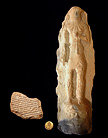Literature
Writing was used in the ancient Middle East for a wide array of purposes: there are administrative and legal records of various kinds, personal letters, international treaties, chronicles and royal inscriptions detailing the deeds of kings, magical and religious texts, as well as medical and astronomical texts among other scholarly genres. There are also many texts that we would identify as literature, although there is considerable overlap between literature and other genres, particularly religious texts, which include hymns and prayers. Many literary texts are narratives that deal with the mythology and exploits of the gods, some focus on the deeds of legendary kings, while others are so-called wisdom or instructional literature, such as moral tales, debates, and proverbs. In the mid-third millennium (ca. 2500 BCE) there is evidence of an incipient written literary tradition from Mesopotamia; texts from this period include some instructional literature and myths, which likely had their origins in a rich oral tradition. These texts are contemporaneous with the earliest religious literature from Egypt in the form of the pyramid texts.
Better known compositions, narratives that may be regarded as exemplary of ancient Near Eastern literature, are known primarily from the second and first millennia BCE. These include such Middle Kingdom Egyptian stories as the Shipwrecked Sailor, the Story of Sinuhe, and the Tale of the Eloquent Peasant. From Mesopotamia there is the famous Epic of Gilgamesh, Atrahasis, the Mesopotamian ‘Noah’ (see Framing the issues #2), and the Enuma Elish, which celebrates the god Marduk’s rise to the head of the Babylonian pantheon, among many other compositions. From Anatolia, there are Hititte myths and epics that date to the mid-second millennium. Hittite, an Indo-European language, was written in the syllabic cuneiform script borrowed from Mesopotamia (see A. Writing). While much of this literature pertains to native Hittite and Hurrian religion and legend — as is the case with the Illuyanka Tales, the Disappearance of Telipinu, and the Kumarbi Cycle — there are also Hittite versions of Babylonian stories, such as the Epic of Gilgamesh and legends relating to the early Mesopotamian kings Sargon and Naram-Sin, who ruled at the end of the third millennium (ca. 2300 BCE).
Ancient Middle Eastern literature also includes an important corpus of Canaanite myths and epics, such as Aqhat (the son of Daniel of Biblical fame) and the Baal cycle (describing the storm god’s defeat of the powers of chaos and subsequent ascent to kingship), dating to the late second millennium and excavated from the city-state of Ugarit on the Syrian coast. These stories, written in alphabetic cuneiform, are critical for understanding early Canaanite religion and display many parallels in terms of both theme and poetic style to biblical poetry, as well as to the literatures of Egypt and Mesopotamia. Of course, not to be overlooked in this connection, is the best-known and most influential of ancient Near Eastern literature, namely, the collection of writings, composed, roughly, during the thousand-year period between the end of the second millennium (ca. 1200 BCE) and the end of the first (ca. 200 BCE), which came to constitute the Hebrew Bible (the Christian Old Testament).

 Christopher Woods
Christopher Woods
Associate Professor of Sumerology, University of Chicago
Guiding Questions
1. Why do you think writing evolved from early hieroglyphic script to the later Coptic form?
2. Why did early writers incorporate literature into their work?
3. How does the invention of writing impact us today?


 Print Page
Print Page

